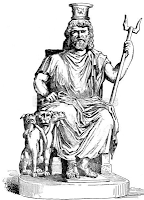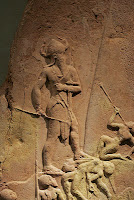Renaissance Serapis.The myth of the secret nature of Pagan myth..
Plato
...declared that philosophy itself was a mystical initiation.
Rigorous intellectual effort could accomplish the cleansing of the soul, free it from ignorance.
Philosophy, according to Plato, closed the distance between the individual and Ultimate Truth.
Despite his best intentions, Plato created a new modification of an old theme, Platonism in its turn became a mystery religion, offering initiations that promise the soul a better after-life, after death. One assumes that these grades of initiation were exams!
The essential difference between what is labelled Platonism and labelled Orphism is the imperative to think ones way into a higher reality, as opposed to the sufficiency of experience for an Orphic initiation. Both Platonism and Orpheus had their mysteries, but in an Orphic religion, initiations were marked on a calendar The location and date of the initiation was not a closed secret, whilst what happened during the mystery was another matter.
Mysteries were necessarily incomprehensible to most initiates.
Being off your head after fasting and sleep deprivation were considered beneficial or at least helpful in opening the mind of the initiate to a state beyond words.
What experience was held to accomplish, Plato demands that it be done by pure reason alone: no drugs, no priests, no mystical experiences; only by rational exercise in the art of dialectic may the soul be purged of error.
Being off your head would not help at all.
Over a thousand years latter, there remains within Platonism a belief in codes, hidden messages, magic numbers; keys to unlock secret knowledge left by those who know, for those who seek to know.
This more mystical version of Plato came primarily through translations of Plotinus.
In the fifteenth century, Plotinus was translated into Latin in the fifteenth century by De Bussi, Beroaldo, Perotti, Landino and especially Ficino and Mirandola. The Neoplatonists believed that the interpretation of images was part of Plato's original philosophy: that statues, paintings, buildings and even music perhaps, contained secret messages. Any secrets hidden within the work of the ancients would be encoded in form that could be read only by a very select few.
Pico della Mirandola
(24 February 1463 – 17 November 1494)
wrote:
Serapis
 ... Serapis was a deity instituted by Ptolemy Sotor, the Greek ruler of Egypt who needed a deity that could be worshipped by both his Greek and his Egyptian subjects.
... Serapis was a deity instituted by Ptolemy Sotor, the Greek ruler of Egypt who needed a deity that could be worshipped by both his Greek and his Egyptian subjects.
The name Serapis is a combination of the names Osiris and Apis. Osiris is the Egyptian lord of the dead, and the Greeks associated Serapis with their own ruler of the underworld, Hades.
Plutarch records:(On Isis and Osiris) that Ptolemy had a dream about a statue that would be found in the Greek town of Sinope.
The statue spoke in the dream to Ptolemy and told the king to move it to Alexandria. Three years latter, this was done.
Plutarch again:
 Now why or even if the dog who guards the gates of the Underworld has three heads, is a bit of a problem. Sometimes images show three dogs, Cerberus and his pups, three distinct dogs, other times a two headed dog.
Now why or even if the dog who guards the gates of the Underworld has three heads, is a bit of a problem. Sometimes images show three dogs, Cerberus and his pups, three distinct dogs, other times a two headed dog.
Hesiod describes a fifty-headed dog:
This vase made in Caere in 525 BC shows Cerberus with three heads.
But for the Neoplatonists, the three headed Cerberus was a symbol rich with inner meanings
Ambrosius Theodosius Macrobius was a Roman grammarian and Neoplatonist philosopher (395–423 AD) describes the stature of Serapis at Alexandria. Unfortunately it is unlikely that he ever saw because it was destroyed in 392 AD after the decree of Theodosius I (378 to 395 AD) outlawing non-Christian worship.
Nevertheless Macrobius undaunted, describes the statue.
Here is his account:
Perhaps there were other statues of Serapis for him to study..
But his Serapis has gained a lion, a wolf, and a snake instead of his triple headed dog.

It is clear from his writing that Macrobius believes that Serapis is a sun god- that all gods are the sun, whilst he includes the snake because it is an emblem of sovereignty as depicted on the headdress of ancient Egyptian rulers and deities. He also includes the snake as the flow of time, linking the past to the present to the future.
His Cerbeus becomes a chimera.
The three heads signify the three parts of time: the ferocious wolf facing left, represents vanished time -the past.
The hopeful dog looks to the right, anticipating something good, the future.
While the splendid lion faces directly ahead, embodying the present.
The images remain remarkably constant.
Though it seems obvious that the past has gone, devoured by time, this isn't the only way to perceive time. Both in Hebrew and Akkadian it is implied that we face the past and the past is all we see. Meanwhile the future is impossible to see because it is behind us.
Finally
There is a time-god called Aion by the Greeks, known as Zervan in Persian literature; a lion headed man, serpent coiled around his legs.
He holds a hammer/thunderbolt and is associated with the cult of Mithras.
As Chronos (Time), Zervan became Kronos and, in the Roman world, Saturn. In the Mithraic version, the birth of Mithras portrays the god, entwined by a serpent, is surrounded by the signs of the zodiac and the four Wind-gods.
As Mahakala- Great Time
And so the image rolls on and on...
...declared that philosophy itself was a mystical initiation.
Rigorous intellectual effort could accomplish the cleansing of the soul, free it from ignorance.
Philosophy, according to Plato, closed the distance between the individual and Ultimate Truth.
Despite his best intentions, Plato created a new modification of an old theme, Platonism in its turn became a mystery religion, offering initiations that promise the soul a better after-life, after death. One assumes that these grades of initiation were exams!
The essential difference between what is labelled Platonism and labelled Orphism is the imperative to think ones way into a higher reality, as opposed to the sufficiency of experience for an Orphic initiation. Both Platonism and Orpheus had their mysteries, but in an Orphic religion, initiations were marked on a calendar The location and date of the initiation was not a closed secret, whilst what happened during the mystery was another matter.
Mysteries were necessarily incomprehensible to most initiates.
Being off your head after fasting and sleep deprivation were considered beneficial or at least helpful in opening the mind of the initiate to a state beyond words.
What experience was held to accomplish, Plato demands that it be done by pure reason alone: no drugs, no priests, no mystical experiences; only by rational exercise in the art of dialectic may the soul be purged of error.
Being off your head would not help at all.
Over a thousand years latter, there remains within Platonism a belief in codes, hidden messages, magic numbers; keys to unlock secret knowledge left by those who know, for those who seek to know.
This more mystical version of Plato came primarily through translations of Plotinus.
In the fifteenth century, Plotinus was translated into Latin in the fifteenth century by De Bussi, Beroaldo, Perotti, Landino and especially Ficino and Mirandola. The Neoplatonists believed that the interpretation of images was part of Plato's original philosophy: that statues, paintings, buildings and even music perhaps, contained secret messages. Any secrets hidden within the work of the ancients would be encoded in form that could be read only by a very select few.
Pico della Mirandola
(24 February 1463 – 17 November 1494)
wrote:
"that divine subjects and the secret Mysteries must not be rashly divulged...that is why the Egyptians had sculptures of sphinxes in all their temples, to indicate that divine knowledge, if committed to writing at all, must be covered with enigmatic veils and poetic dissimulation"
Serapis
 ... Serapis was a deity instituted by Ptolemy Sotor, the Greek ruler of Egypt who needed a deity that could be worshipped by both his Greek and his Egyptian subjects.
... Serapis was a deity instituted by Ptolemy Sotor, the Greek ruler of Egypt who needed a deity that could be worshipped by both his Greek and his Egyptian subjects.The name Serapis is a combination of the names Osiris and Apis. Osiris is the Egyptian lord of the dead, and the Greeks associated Serapis with their own ruler of the underworld, Hades.
Plutarch records:(On Isis and Osiris) that Ptolemy had a dream about a statue that would be found in the Greek town of Sinope.
The statue spoke in the dream to Ptolemy and told the king to move it to Alexandria. Three years latter, this was done.
Plutarch again:
"Timotheus the Interpreter, and Manetho, as soon as the statue was shown to them, from the Cerberus and Dragon that accompanied it, concluded that it was designed to represent Pluto, and persuaded the king that it was in reality none other than the Egyptian Sarapis; for it must be observed, that the statue had not this name before it was brought to Alexandria, it being given to it afterwards by the Egyptians, as equivelent, in their opinion, to its old one of Pluto."By Serapis-Pluto sits the three headed dog, Cerberus.
 Now why or even if the dog who guards the gates of the Underworld has three heads, is a bit of a problem. Sometimes images show three dogs, Cerberus and his pups, three distinct dogs, other times a two headed dog.
Now why or even if the dog who guards the gates of the Underworld has three heads, is a bit of a problem. Sometimes images show three dogs, Cerberus and his pups, three distinct dogs, other times a two headed dog.Hesiod describes a fifty-headed dog:
Men say that Typhaon the terrible, outrageous and lawless, was joined in love to her, the maid with glancing eyes. So she conceived and brought forth fierce offspring; first she bare Orthus the hound of Geryones, and then again she bare a second, a monster not to be overcome and that may not be described, Cerberus who eats raw flesh, the brazen-voiced hound of Hades, fifty-headed, relentless and strong.
This vase made in Caere in 525 BC shows Cerberus with three heads.
But for the Neoplatonists, the three headed Cerberus was a symbol rich with inner meanings
Ambrosius Theodosius Macrobius was a Roman grammarian and Neoplatonist philosopher (395–423 AD) describes the stature of Serapis at Alexandria. Unfortunately it is unlikely that he ever saw because it was destroyed in 392 AD after the decree of Theodosius I (378 to 395 AD) outlawing non-Christian worship.
"no one is to go to the sanctuaries, walk through the temples, or raise his eyes to statues created by the labor of man"
Nevertheless Macrobius undaunted, describes the statue.
Here is his account:
"In the city on the borders of Egypt which boasts Alexander of Macedon as its founder, Sarapis and Isis are worshiped with a reverence that is almost fanatical. Evidence that the sun, under the name of Sarapis, is the object of all this reverence is either the basket set on the head of the god or the figure of a three-headed creature placed by his statue. The middle head of this figure, which is also the largest, represents a lion's; on the right a dog raises its head with a gentle and fawning air; and on the left the neck ends in the head of a ravening wolf. All three beasts are joined together by the coils of a serpent whose head returns to the god's right hand which keeps the monster in check." - Macrobius, Saturnalia I.20.13
Perhaps there were other statues of Serapis for him to study..
But his Serapis has gained a lion, a wolf, and a snake instead of his triple headed dog.

It is clear from his writing that Macrobius believes that Serapis is a sun god- that all gods are the sun, whilst he includes the snake because it is an emblem of sovereignty as depicted on the headdress of ancient Egyptian rulers and deities. He also includes the snake as the flow of time, linking the past to the present to the future.
His Cerbeus becomes a chimera.
The three heads signify the three parts of time: the ferocious wolf facing left, represents vanished time -the past.
The hopeful dog looks to the right, anticipating something good, the future.
While the splendid lion faces directly ahead, embodying the present.
 |
| Titian: Allegory. |
Though it seems obvious that the past has gone, devoured by time, this isn't the only way to perceive time. Both in Hebrew and Akkadian it is implied that we face the past and the past is all we see. Meanwhile the future is impossible to see because it is behind us.
Finally
There is a time-god called Aion by the Greeks, known as Zervan in Persian literature; a lion headed man, serpent coiled around his legs.
He holds a hammer/thunderbolt and is associated with the cult of Mithras.
As Chronos (Time), Zervan became Kronos and, in the Roman world, Saturn. In the Mithraic version, the birth of Mithras portrays the god, entwined by a serpent, is surrounded by the signs of the zodiac and the four Wind-gods.
As Mahakala- Great Time
And so the image rolls on and on...
 |
| Mahakala. |



